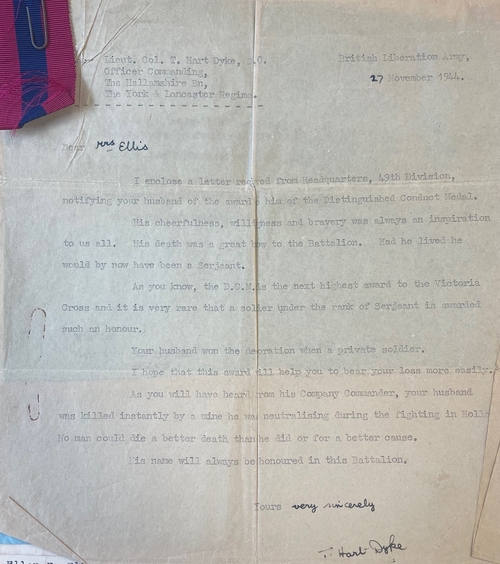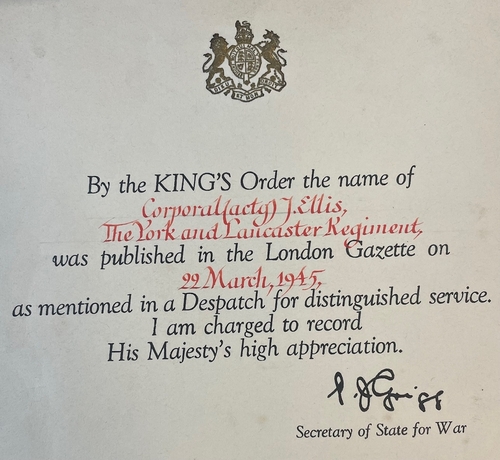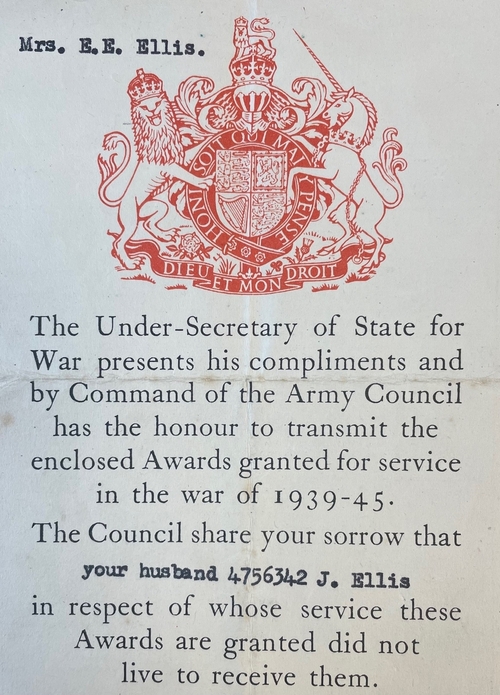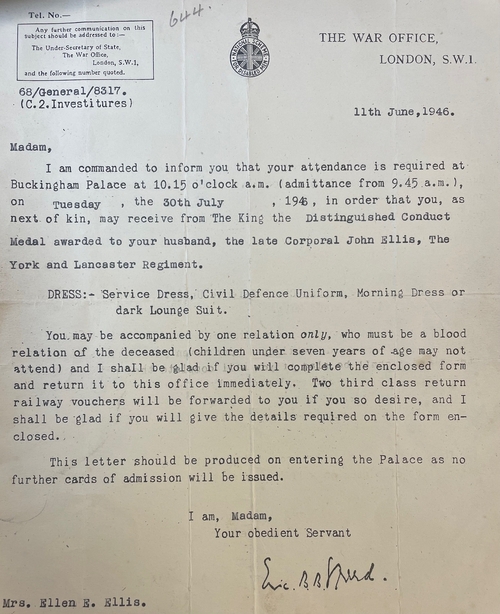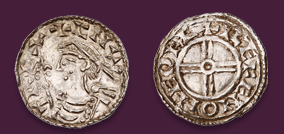Auction: 25003 - Orders, Decorations and Medals
Lot: 250
'Dear Mrs Ellis,
I enclose a letter received from HQ, 49th Division, notifying your husband of the award to him of the Distinguished Conduct Medal.
His cheerfulness, willingness and bravery was always an inspiration to us all. His death was a great blow to the Battalion. Had he lived he would by now have been a Serjeant.
As you know, the D.C.M. is the next highest award to the Victoria Cross and it is very rare that a soldier under the rank of Serjeant is awarded such an honour.
Your husband won the decoration when a Private soldier.
I hope that this award will help you to bear your loss more easily. As you will have heard from his Company Commander, your husband was killed instantly by a mine he was neutralising during the fighting in Holland.
No man could die a better death than he did or for a better cause. His name will always be honoured in this Battalion.
Yours very sincerely, T. Hart-Dyke.'
So wrote Lieutenant-Colonel Hart-Dyke on 27 November 1944.
The poignant D.C.M. group of five awarded to Corporal J. Ellis, Pioneer Platoon, 4th (Hallamshire) Battalion, York and Lancaster Regiment, a mine clearance specialist
Having taken his outstanding award for his efforts in creating the bridgehead over the River Touques, he was wounded during the unit's Victoria Cross action on 29 September 1944, before being killed in action on 5 November 1944, again whilst attempting to clear enemy mines; he would also take a posthumous 'mention' to add to his laurels, which appears to have been won during Operation Astonia - the breaking of Festung Le Havre - in August 1944
Distinguished Conduct Medal, G.VI.R. (4756342 Pte. J. Ellis. Y. & L. R.); 1939-45 Star; France and Germany Star; Defence and War Medals 1939-45, with M.I.D. oak leaf, nearly extremely fine (5)
D.C.M. London Gazette 1 March 1945. The citation - originally for an Immediate M.M. but upgraded to the D.C.M. and approved by Field Marshal Montgomery - states:
'On 20th August 1944 the Battalion was ordered to make a bridgehead over the river TOUQUES near OUILLY LE VINCOMPTE (NW France Normandy region). The enemy who was determined to hold up our advance, had blown every single bridge over the river, and taken up extremely strong positions on the high ground on the further side. From these positions they had a perfect field of view and field of fire on to any target which might appear on the river bank. The Pioneer Platoon, who owing to casualties were without either an officer or a sergeant, were ordered to throw an improvised bridge over the site of one which had been blown.
The Platoon were faced with two main difficulties in carrying out this task. The first was the heavy concentration of mortar and small arms fire which rained down upon them as soon as they approached the water's edge, and continued through the entire operation, the second being the fact that there was no authorised bridging material whatsoever at their disposal. Immediately Private ELLIS took charge of the proceedings and looking about him, quickly spotted some telegraph poles which he told his party to fetch and lay across the river to form a base for the bridge. Meanwhile, he found some timber which had been used for construction of German dug outs, and this and other improvised materials which he discovered in different places in the area, he had carried down to the water's edge.
In addition to mortar and small arms, shells were now landing all around the bridge site, ELLIS, however, so inspired the Platoon by his own complete disregard for personal safety, that the job was completed in two hours, and the entire fighting echelon vehicles of the Battalion, the heaviest weighing nine tons, were able to pass over. ELLIS's display of courage and initiative in getting this bridge built, contributed to a large extent to the Divisional advance, as the Battalion being thus enabled to get forward, achieved the bridgehead which allowed the Royal Engineers to construct the bridge over which the main body crossed.'
M.I.D. London Gazette 22 March 1945.
John Ellis was a native of Newport Street, Leeds, West Yorkshire and served overseas with the Pioneer Platoon of the 4th (Hallamshire) Battalion, York and Lancaster Regiment. Details of the probable award for his M.I.D. were reported in the Leeds Evening Post of 23 November 1944:
'Leeds Corporal among mines
‘A ticklish undertaking successfully carried through by a Leeds corporal (who has since been killed), at the time when our troops were fighting their way into Havre, is disclosed today by a military observer. It was found (he writes) that all the approaches to the tow, and large parts of the town itself had been heavily mined. In addition, much of the dock area had been prepared for demolition, so that a switch merely had to be turned from any of the numerous control points to blow up an area half a mile away.
In the latter stages of the battle only two bridges remained, connecting the mainland to the docks, where considerable numbers of the enemy were holding out. One of these bridges crossed the river, and the other the canal running parallel to it. An assault section of the Hallams pioneer specialists, was called up by the tanks to examine the bridges to see if they were mined. The NCO in charge of the section, Corporal J Ellis of Newport Street, Leeds 10 went forward alone onto the bridges, which he found riddles with mines. Carefully cutting the wires leading from the mines to the electrical charge which was to set them off, he removed the mines themselves, thus clearing the route for the vehicles to cross over onto the docks and finish off the enemy's final resistance.
Afterwards Corporal Ellis traced the wires back to the control house where he discovered the switches. He has since been killed in action, he was 30 and formerly worked at Morrish's Coach Builders, Donisthorpe Street.'
Having undertaken that escapade, he was to be wounded in action on 29 September 1944, when his Battalion comrade Corporal John William Harper took the Victoria Cross.
Writing to his son during the last few weeks of his life, Ellis penned:
'Daddy wants to come home to see mother and you but we must beat the Germans first so that you can go to school and be taught the things which are necessary for peace and love...be a good boy until daddy comes home and then we shall have lots of fun and games. Cheerio old man we shall meet again soon.'
It was not to be for he was killed in action in the outskirts of Oude Molen on 5 November 1944. He had been clearing enemy mines in the streets to allow his comrades to carry home the attack. His widow Ellen would go up to Buckingham Palace to take his D.C.M. from the hands of The King on 30 July 1946. Ellis was buried in the Roosendaal-en-Nispen Cemetery, Holland.
Sold together with his original M.I.D. certificate, named condolence slip, his letters home, letters of condolence - including from his Pioneer Platoon who raised over £25 for his family via subscription - and newspaper clippings, together with copied research.
Subject to 20% VAT on Buyer’s Premium. For more information please view Terms and Conditions for Buyers.
Estimate
£4,000 to £6,000
Starting price
£3200



